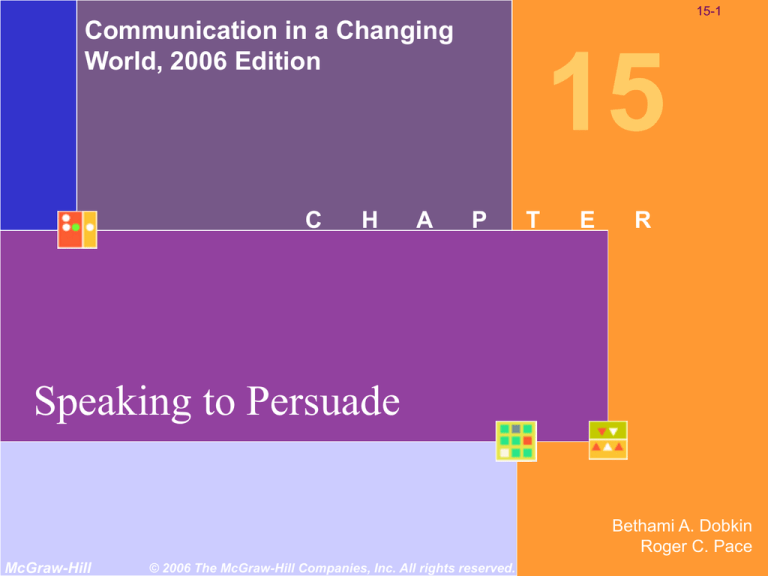
15-1
Communication in a Changing
World, 2006 Edition
C
H
A
15
P
T
E
R
Speaking to Persuade
Bethami A. Dobkin
Roger C. Pace
McGraw-Hill
© 2006 The McGraw-Hill Companies, Inc. All rights reserved.
15-2
Speaking to Persuade
•
•
•
•
•
The Informative-Persuasive Continuum
Types of Persuasive Speeches
Building Persuasive Arguments
Putting It All Together
Communicating Responsibly: Recognizing
and Practicing Ethical Persuasion
McGraw-Hill
© 2006 The McGraw-Hill Companies, Inc. All rights reserved.
15-3
The Informative-Persuasive
Continuum
• Speaking to Inform Involves an Element of
Persuading
– Each of the informative speech types can
overlap with the persuasive speaking
• Speaking to Persuade Involves an Element
of Informing
– During a persuasive speech, speakers are likely
to give the audience new information, convey
ideas, and perhaps tell a story
McGraw-Hill
© 2006 The McGraw-Hill Companies, Inc. All rights reserved.
15-4
The Informative-Persuasive
Continuum Figure 15-1. The Informative-Persuasive Continuum
The more change a speaker asks from an audience, the more challenging
the presentation.
McGraw-Hill
© 2006 The McGraw-Hill Companies, Inc. All rights reserved.
15-5
The Informative-Persuasive
Continuum
• Effective Persuasive Speakers Know Their
Audiences
– Added challenge of how audience members are
likely to judge the beliefs they are being asked
to accept
• Social judgment theory—evaluation of persuasive
messages based on the beliefs we already hold
• Anchors—attitudes or beliefs that act as a personal
standard for judging other messages
• Latitude of acceptance—the range of positions a
listener is likely to accept or tolerate
McGraw-Hill
© 2006 The McGraw-Hill Companies, Inc. All rights reserved.
15-6
The Informative-Persuasive
Continuum
• Effective Persuasive Speakers Know Their
Audiences (continued)
• Latitude of noncommittment—the range of
positions a listener neither accepts or rejects
• Latitude of rejection—the range of positions a
listener is likely to reject or consider intolerable
McGraw-Hill
© 2006 The McGraw-Hill Companies, Inc. All rights reserved.
15-7
The Informative-Persuasive
Continuum
Figure 15-2. Dimensions of Audience Attitudes
Latitudes of acceptance, noncommittment, and rejection vary based on personal
investment in a belief.
McGraw-Hill
© 2006 The McGraw-Hill Companies, Inc. All rights reserved.
15-8
Types of Persuasive Speeches
• Speeches that Reinforce
– A speech that reinforces tries to strengthen
existing attitudes, beliefs, or values by
bolstering attitudes and convictions that the
audience already posses
McGraw-Hill
© 2006 The McGraw-Hill Companies, Inc. All rights reserved.
15-9
Types of Persuasive Speeches
• Speeches that convince
– A speech that convinces urges listeners to
accept contentious facts, evaluate beliefs, or
support actions
• Claims of fact—statements about the truth or falsity
of some assertion or claim
• Claims of value—statements that ask listeners to
form a judgment or evaluation
• Claims of policy—statements that ask listeners to
consider a specific course of action
McGraw-Hill
© 2006 The McGraw-Hill Companies, Inc. All rights reserved.
15-10
Types of Persuasive Speeches
“The main dangers in this life are the people
who want to change everything . . . Or
nothing.”
—Lady Nancy Astor, first woman member
of the British parliament
McGraw-Hill
© 2006 The McGraw-Hill Companies, Inc. All rights reserved.
15-11
Types of Persuasive Speeches
• Speeches that Call for Action
– A speech that calls for action builds on the
support a speaker has earned and moves the
audience to a specific behavior
McGraw-Hill
© 2006 The McGraw-Hill Companies, Inc. All rights reserved.
15-12
Building Persuasive Arguments
• One of the first decisions to make in
planning your persuasive speech is which
type of claim—fact, value, or policy—will
become the thesis for your presentation
– Create Your Propostional Statement
– Define Your Claim, Reasons, and Evidence
• See Persuasive Presentation Sentence Outline
Example
McGraw-Hill
© 2006 The McGraw-Hill Companies, Inc. All rights reserved.
15-13
Building Persuasive Arguments
• Persuasion Based on Credibility
– Ethos refers to the ethics or credibility of the
speaker
McGraw-Hill
© 2006 The McGraw-Hill Companies, Inc. All rights reserved.
15-14
Building Persuasive Arguments
• Persuasion Based on Logic
– The claims a speaker makes are only as solid as
the evidence and reasoning that support them
• Logos refers to arguments based on logic or reason
McGraw-Hill
© 2006 The McGraw-Hill Companies, Inc. All rights reserved.
15-15
Building Persuasive Arguments
• Persuasion Based on Emotional Appeals
– The word pathos refers to arguments based on
emotional appeals or appeals to values
•
•
•
•
•
Basic Needs and Desires
Security
Belonging
Love and Esteem
Self-Actualization
– When paired with logical appeals, pathos can be
powerful, particularly with audiences who are
skeptical or hostile
McGraw-Hill
© 2006 The McGraw-Hill Companies, Inc. All rights reserved.
15-16
Summary
• Persuasive speeches share much with
informative ones
• There are three types of persuasive
speaking: speeches that reinforce, convince,
or call for action
• Claims of fact, value, and policy each reflect
a different goal of the speaker and desired
response from listeners
• Arguments consist of claims, evidence, and
reasoning
McGraw-Hill
© 2006 The McGraw-Hill Companies, Inc. All rights reserved.





